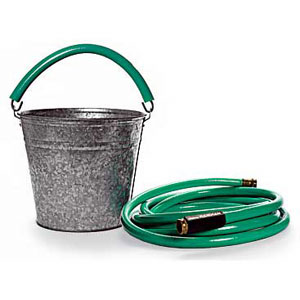 Watering equipment can be costly, but it may save you in the long run by lowering your water bills or pumping costs. Water containers are for carrying and dispensing water. Stores sell all kinds of expensive watering cans, but you can make cheap imitations. Plastic milk or water jugs are ideal. Punch holes in the bottom, put on the cap, and carry upside-down. Turn them over, and remove the cap to sprinkle water.
Watering equipment can be costly, but it may save you in the long run by lowering your water bills or pumping costs. Water containers are for carrying and dispensing water. Stores sell all kinds of expensive watering cans, but you can make cheap imitations. Plastic milk or water jugs are ideal. Punch holes in the bottom, put on the cap, and carry upside-down. Turn them over, and remove the cap to sprinkle water. Garden hoses carry water from a faucet to its final destination. They vary in length and can be screwed together to cover long distances. Water pressure from the source forces water through the hose to the end. Rubber and vinyl hoses are the most common, and are available in 1/2-inch, 5/8-inch, 3/4-inch, and 1-inch diameters. Rubber lasts the longest and is least prone to kinking and splitting. For most uses a 5/8-inch size is the best buy. Look for hoses with a lifetime guarantee. Hoses go on sale in spring and fall.
Lawn sprinklers attach to a hose and spray water up and out. They are a tremendous improvement over hand watering for the time they save. Water pressure propels the spray in one of several patterns, with some types covering a larger area than others. The cheapest sprinklers cost between $5 and $8 and are small heads with holes punched in them. They rest on the ground and shoot water up over a limited area. These work all right for lawns, but in a border or vegetable garden the spray may be blocked by foliage. Rotating and pulse-jet sprinklers have moving parts that deliver an even spray. Impulse-jet types are the most versatile, because you can adjust them to water a range of patterns, including a full circle. Oscillating sprinklers have a rocking bar that sprays water. They are not the best for vegetable plots, flower borders, or landscaping plants, because so much water lands on foliage instead of near the roots. If you must use a sprinkler in these spots, elevate it with a step-ladder or other substitute so the spray lands unobstructed. Look for sales in spring and fall.
Drip irrigation systems deliver water through emitters to individual plants. They are great for putting just the right amount of water where needed, but can be costly to install.
Soaker hoses and porous hoses deliver water along their length either through a series of holes, the soaker hose, or through the porous skin. Use some soaker hoses to water lawns as the holes are large enough to send water spraying upward. Turn them over so the water sprays downward to water vegetables or flowers. These hoses conserve water by putting it only where desired by the gardener. Place one along each garden row, or wind through flower beds and landscaping, to save time moving them around. Attach a garden hose when ready to water. Though a soaker hose is a bigger initial expense than a garden hose or cheap sprinkler, the savings on water can pay for the hoses in a couple of seasons. They also will last indefinitely.
Timers shut the water off at a pre-determined time. Cheap ones simply turn it off after a preset time period, while you can program expensive computer models with a complete watering regime. Both models prevent waste from overwatering, but the less expensive mechanical type is simpler to use and should be sufficient for almost anyone.
Water gauges measure how much water lands at a given spot. Save money by placing an empty jar or can in areas you want to measure.


 These are the fundamental tools necessary for gardening. They do not contribute to air or noise pollution, cost virtually nothing to operate, and require little cleaning and maintenance. Yet with a little people-power, these tools perform any task in the garden.
These are the fundamental tools necessary for gardening. They do not contribute to air or noise pollution, cost virtually nothing to operate, and require little cleaning and maintenance. Yet with a little people-power, these tools perform any task in the garden.